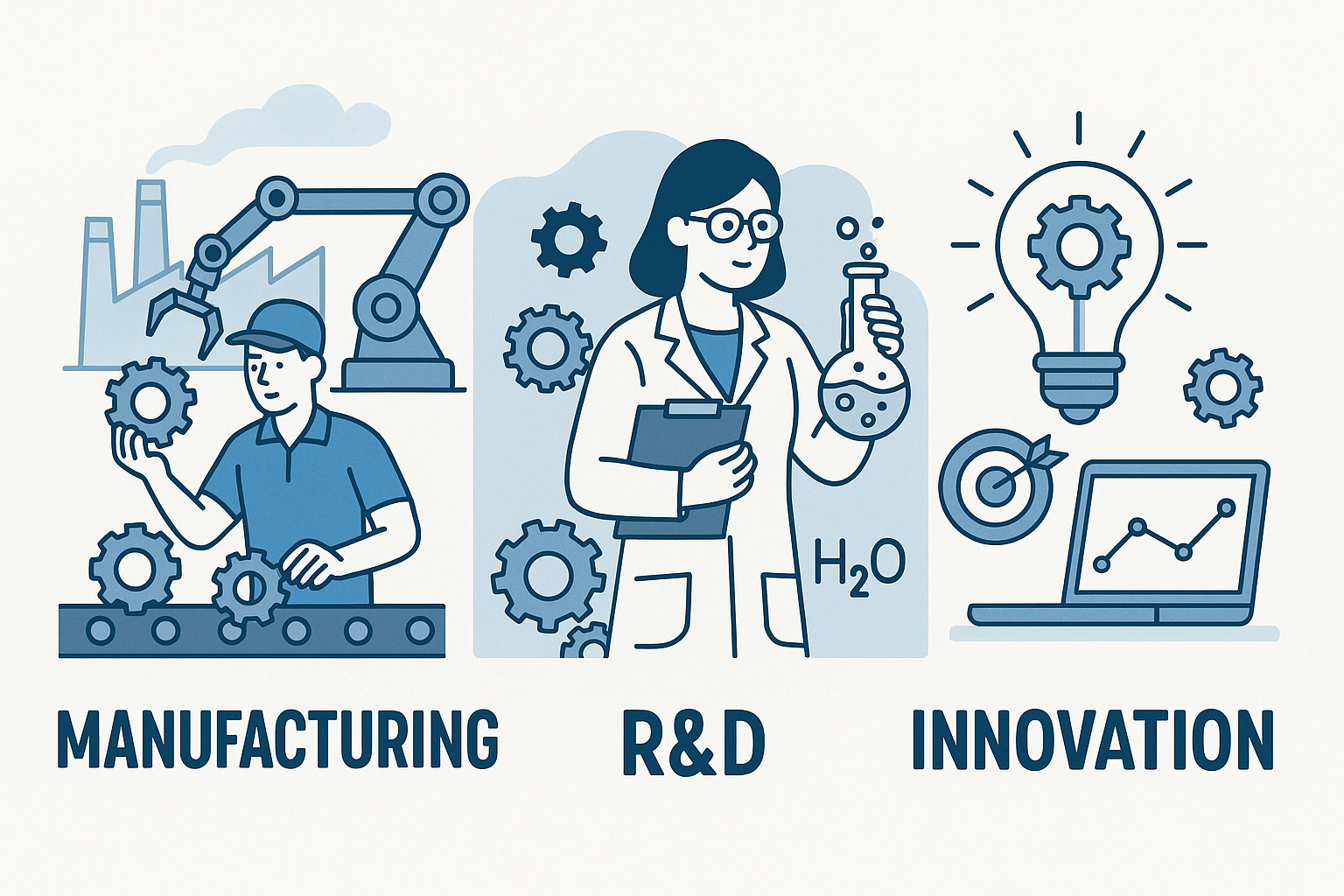R&D Tax Credits for Manufacturing: Complete Qualification Guide
Discover how your manufacturing company can qualify for valuable R&D tax credits and significantly reduce your tax burden while investing in innovation.

Mendel Schapira, CPA
CEO - CPA, Schapira CPA
Published: March 19, 2024 • 15 min read

Why R&D Tax Credits Matter for Manufacturers
Manufacturing companies account for 60% of all R&D tax credits claimed, yet many eligible manufacturers still miss this opportunity.
Table of Contents
Free R&D Assessment
Get a complimentary evaluation of your R&D tax credit opportunities.
Schedule AssessmentKey Benefit
The federal R&D tax credit can reduce your federal tax liability by up to 20% of qualified research expenses. Additionally, many states offer their own R&D tax credits, potentially doubling your savings.
Unlocking R&D Tax Credits for Manufacturers
The Research and Development (R&D) Tax Credit represents one of the most valuable yet underutilized tax incentives available to manufacturing companies. Many manufacturers engage in qualifying R&D activities every day without realizing they're eligible for significant tax savings.
According to recent industry data, manufacturing companies account for approximately 60% of all R&D tax credits claimed, yet many eligible manufacturers still fail to take advantage of this opportunity. This comprehensive guide will help you understand if your manufacturing business qualifies, what activities are eligible, and how to successfully claim these valuable credits.
Basic Eligibility Requirements
To qualify for the R&D tax credit, your manufacturing activities must meet the IRS's four-part test:
Permitted Purpose
The activity must be intended to develop or improve the functionality, performance, reliability, or quality of a:
- Product
- Process
- Software
- Technique, Formula, or Invention
Technological in Nature
The activity must rely on principles of:
- Engineering
- Physical sciences
- Biological sciences
- Computer science
Elimination of Uncertainty
The activity must be intended to eliminate uncertainty regarding:
- The capability to develop or improve the product or process
- The method by which the product or process can be developed
- The appropriate design of the product or process
Process of Experimentation
The activity must involve a process of:
- Evaluating alternatives
- Conducting testing and/or modeling
- Refining or discarding hypotheses
Qualifying Manufacturing Activities
Many common manufacturing activities can qualify for the R&D tax credit. Here are some examples:
Product Development
- Designing and developing new products
- Improving existing products for better performance
- Developing prototypes and first articles
- Testing new materials or components
Process Improvements
- Designing more efficient production processes
- Implementing automation or robotics
- Developing lean manufacturing techniques
- Creating innovative tooling or fixtures
Technology Integration
- Implementing Industry 4.0 technologies
- Developing IoT applications
- Creating digital twins of products
- Integrating AI or machine learning
Case Study: Advanced Composites Manufacturer
A manufacturer of advanced composite materials for the aerospace industry claimed $380,000 in R&D tax credits for activities including:
- Developing new composite formulations with improved strength-to-weight ratios
- Creating innovative curing processes to reduce production time
- Designing new quality control methods for composite integrity
- Developing automated layup techniques for complex geometries
Qualified Research Expenses (QREs)
Once you've identified qualifying activities, you need to determine which expenses associated with these activities can be claimed as Qualified Research Expenses (QREs):
Wages
Salaries and compensation for employees directly engaged in qualified research activities
- • Engineers and designers
- • Production personnel in R&D
- • Quality control staff
- • Direct supervisors
Supplies
Materials consumed or used in the R&D process
- • Prototype materials
- • Test materials
- • Testing components
- • Development scrap
Contract Research
65% of amounts paid to third parties for qualified research
- • Engineering consultants
- • Testing laboratories
- • Universities
- • Research institutions
Cloud Computing
Software development and cloud resources for R&D purposes
- • Development software
- • Cloud computing costs
- • Testing platforms
- • Simulation software
Calculating the R&D Tax Credit
There are two methods for calculating the federal R&D tax credit:
Regular Credit Method
The regular credit is 20% of the current year's QREs that exceed a base amount, calculated using historical research expenses and gross receipts.
Best for: Companies with detailed historical R&D data and consistent research spending patterns.
Alternative Simplified Credit (ASC)
The ASC is 14% of the current year's QREs that exceed 50% of the average QREs for the three preceding tax years.
Most Popular: Simpler calculation and easier to obtain required data. 6% rate for companies without prior QREs.
Example Calculation (ASC Method)
QREs by Year:
- 2021: $800,000
- 2022: $900,000
- 2023: $1,000,000
- 2024 (current): $1,500,000
Calculation:
- Average prior 3 years: $900,000
- Base amount (50%): $450,000
- Excess QREs: $1,050,000
- R&D Credit: $147,000
Documentation Requirements
Proper documentation is critical for supporting R&D tax credit claims. The IRS requires contemporaneous documentation that establishes both the qualification of activities and the connection between those activities and the claimed expenses.
Technical Documentation
- Project plans and technical specifications
- Design documents and engineering drawings
- Test protocols and results
- Prototype records and photos
- Lab notebooks or development logs
Financial Documentation
- Payroll records for R&D employees
- Time tracking for qualified activities
- Supply purchase records for R&D projects
- Contracts with outside researchers
- Project accounting records
Application Process
The process for claiming the R&D tax credit involves several key steps:
Identify Qualifying Projects and Activities
Review all potential R&D activities across your manufacturing operations, including product development, process improvements, and technology integration projects.
Gather Documentation
Collect both technical and financial documentation to support your claim, including project records, test results, payroll data, and expense tracking.
Calculate Qualified Research Expenses
Determine which expenses qualify as QREs, including wages, supplies, and contract research expenses directly related to qualifying activities.
Complete and File Required Forms
For federal R&D tax credits, you'll need to complete:
- • Form 6765: Credit for Increasing Research Activities
- • Form 3800: General Business Credit
- • State-specific forms for state R&D credits
State R&D Tax Credits
In addition to the federal R&D tax credit, many states offer their own R&D tax incentives. These state credits can often be claimed alongside the federal credit, potentially doubling your tax savings.
Top States for R&D Credits
State Credit Variations
- Credit rates (1% to 40%)
- Different calculation methods
- Varying carryforward provisions
- Refundability options
Additional Benefits
- Can stack with federal credits
- Some states offer transferability
- Immediate cash benefits in some states
- Extended carryforward periods
Common Misconceptions
Many manufacturers miss out on R&D tax credits due to these common misconceptions:
Misconception: "We don't do R&D"
Reality: Many everyday manufacturing activities qualify, including process improvements and product development. You don't need scientists in lab coats!
Misconception: "Projects must be successful"
Reality: Failed projects can qualify as long as they meet the four-part test. The experimentation process itself is what matters, not the outcome.
Misconception: "We need patents to qualify"
Reality: While patents can help support a claim, they are not required. Many qualifying activities never result in patent applications.
Key Takeaways
The R&D tax credit represents a significant opportunity for manufacturing companies to reduce tax liability and reinvest in innovation:
- Many common manufacturing activities qualify, including product development and process improvements
- Both federal and state credits are available, potentially doubling your benefit
- Small and mid-sized manufacturers can use special provisions like the payroll tax offset
- Proper documentation is critical for supporting your claim
- The credit can be claimed retroactively for up to three years
- Expert guidance can streamline the process and maximize benefits
Expert Guidance for Your R&D Tax Credit Claim
At Schapira CPA, we specialize in helping manufacturing companies identify, document, and claim R&D tax credits. Our team of experts can guide you through the entire process, from identifying qualifying activities to preparing a robust technical report that will stand up to IRS scrutiny.
Ready to Claim Your R&D Tax Credits?
Our R&D tax credit specialists have helped manufacturers recover millions in unclaimed credits. Don't let another year pass without claiming what you're entitled to.
